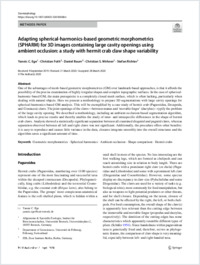Adapting spherical-harmonics-based geometric morphometrics (SPHARM) for 3D images containing large cavity openings using ambient occlusion: a study with hermit crab claw shape variability
- Ege, Yannic C. Allgemeine + Spezielle Zoologie, Institut für Biowissenschaften, Universität Rostock, Universitätsplatz, Rostock, Germany
- Foth, Christian Department of Geosciences, Université de Fribourg, Fribourg, Switzerland
- Baum, Daniel ZIB, Zuse Institute Berlin, Berlin, Germany
- Wirkner, Christian S. Allgemeine + Spezielle Zoologie, Institut für Biowissenschaften, Universität Rostock, Universitätsplatz, Rostock, Germany
- Richter, Stefan Allgemeine + Spezielle Zoologie, Institut für Biowissenschaften, Universität Rostock, Universitätsplatz, Rostock, Germany
-
21.04.2020
Published in:
- Zoomorphology. - 2020, vol. 139, no. 3, p. 421-432
English
One of the advantages of mesh-based geometric morphometrics (GM) over landmark-based approaches, is that it affords the possibility of the precise examination of highly irregular shapes and complex topographic surfaces. In the case of spherical-harmonic-based GM, the main prerequisite is a completely closed mesh surface, which is often lacking, particularly when dealing with natural objects. Here we present a methodology to prepare 3D segmentations with large cavity openings for spherical-harmonics-based GM analysis. This will be exemplified by a case study of hermit crab (Paguroidea, Decapoda, and Crustacea) claws. The joint openings of the claws—between manus and ‘movable finger’ (dactylus)—typify the problem of the large cavity opening. We described a methodology, including an ambient-occlusion-based segmentation algorithm, which leads to precise results and thereby enables the study of inter- and intraspecific differences in the shape of hermit crab claws. Analysis showed a statistically significant separation between all examined diogenid and pagurid claws, whereas separation observed between all left and right claws was not significant. Additionally, the procedure offers other benefits: it is easy to reproduce and causes little variance in the data, closures integrate smoothly into the overall structures and the algorithm saves a significant amount of time.
- Faculty
- Faculté des sciences et de médecine
- Department
- Département de Géosciences
- Language
-
- English
- Classification
- Biological sciences
- License
-
License undefined
- Identifiers
-
- RERO DOC 328428
- DOI 10.1007/s00435-020-00488-z
- Persistent URL
- https://folia.unifr.ch/unifr/documents/308397
Statistics
Document views: 107
File downloads:
- pdf: 143
